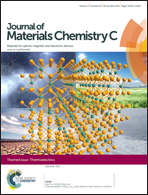Self-assisted nucleation and growth of [010]-oriented Sb2Se3 whiskers: the crystal structure and thermoelectric properties
Abstract
The layered-chalcogenide Sb2Se3 has potential for use in photovoltaic devices and thermoelectric coolers, but its practical applications are restricted as bulk Sb2Se3 exhibits high electrical resistivity (ρ). Herein, we synthesize n-type Te-doped Sb2Se3 whiskers with the average feature size of 1 cm length and 200 μm width via a self-assisted vapor–solid (VS) method. In particular, based on the crystallographic identification using techniques of powder X-ray diffraction and transmission electron microscopy, the Te-doped Sb2Se3 whisker grows along a preferred orientation of [010], which is rarely reported for an orthorhombic structure due to the fact that the bonding energy along the c-axis is much stronger. The [010]-oriented Sb2Se3 whisker shows enhanced electrical conductivity, especially compared with its bulk form, and exhibits a high Seebeck value (S) within 300–400 K, resulting in a peak power factor (S2/ρ) of ∼7.6 (μW m K−2) at 350 K. The peak PF value is 104 higher than that of Sb2Se3 bulk and is comparable to that of Sb2Se3 nanotubes, respectively, giving rise to the possibility of utilizing Sb2Se3 in the application of thermoelectric coolers.
![Graphical abstract: Self-assisted nucleation and growth of [010]-oriented Sb2Se3 whiskers: the crystal structure and thermoelectric properties](/en/Image/Get?imageInfo.ImageType=GA&imageInfo.ImageIdentifier.ManuscriptID=C5TC01364J&imageInfo.ImageIdentifier.Year=2015)
- This article is part of the themed collection: The Chemistry of Thermoelectric Materials

 Please wait while we load your content...
Please wait while we load your content...